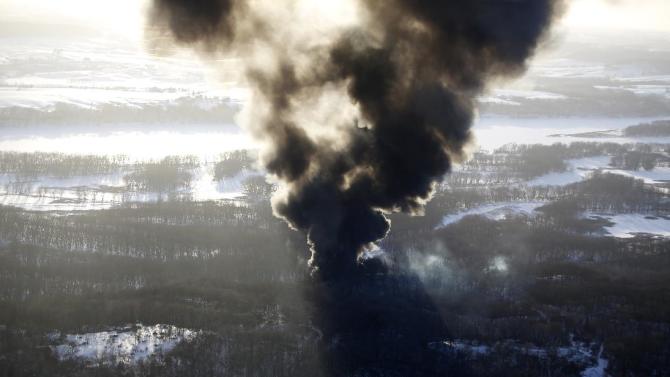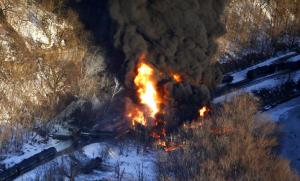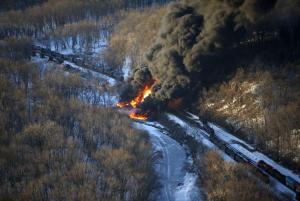You would think these men who are making this shit happen would realize that these "accidents" & spills are NOT going to make us want a pipeline instead.
All these "accidents" are doing is pissing off the public even more and pushing us towards alternative fuel solutions.
AGAIN?! Sign here if you agree that it's PAST time for The White Houseand it's U.S. Department of Transportation to BAN THE BOMB TRAINS:http://bit.ly/BanBombTrains
Illinois oil train derailment involved safer tank cars
GALENA, Ill. (AP) — The rail cars that split open and burst into flames during a western Illinois oil train derailment this week had been retrofitted with protective shields to meet a higher safety standard than federal law requires, railroad officials said.
The fire continued to burn Friday, a day after 21 of the train's 105 cars derailed in a rural area south of the city of Galena. No injuries were reported, but the accident was the latest in a series of failures for the safer tank-car model that has led some people calling for even tougher requirements.
"It certainly begs that question, when ... those standards failed to prevent leakage and explosions that threaten human safety and environmental contamination," said Steve Barg, director of the Jo Daviess Conservation Foundation, which owns a nature preserve several hundred yards from the derailment site.
BNSF Railway said in a news release that the train's tank cars were a newer model known as the 1232, which was designed during safety upgrades voluntarily adopted by the industry four years ago in hopes of keeping cars from rupturing during derailments. But 1232 standard cars involved in three other accidents have split open in the past year.
Those other accidents included one last month in West Virginia in which a train carrying 3 million gallons of North Dakota crude derailed, shooting fireballs into the sky, leaking oil into a waterway and burning down a house. The home's owner was treated for smoke inhalation, but no one else was injured.
In Thursday's accident in Illinois, 21 cars derailed in an area where the Galena River meets the Mississippi. The company said a resulting fire spread to five rail cars, and emergency personnel were still working to contain the blaze Friday.
Firefighters could only access the derailment site by a bike path, said Galena Assistant Fire Chief Bob Conley. They had to pull back initially for safety reasons, but by midday Friday officials described the area as "stable."
The Federal Railroad Administration said its investigators expected to have access to the site around noon.
The train had 103 cars loaded with crude oil from the Northern Plains' Bakken region, along with two buffer cars loaded with sand, according to company spokesman Andy Williams. The cause of the derailment hasn't been determined.
The accident occurred 3 miles south of Galena in a wooded and hilly area that is a major tourist attraction and the home of former President Ulysses S. Grant. It's part of the Driftless Area, a multi-state region prized in the largely flat Midwest for its high bluffs, karst limestone and steep ravines that escaped the last continental glacier.
It is also just alongside part of the Upper Mississippi River Wildlife and Fish Refuge. So far, there's no indication of any oil contamination there, said U.S. Fish and Wildlife Service spokeswoman Georgia Parhan.
As of June of last year, BNSF was hauling 32 Bakken oil trains per week through the surrounding Jo Daviess County, according to information disclosed to Illinois emergency officials.
Recent derailments have increased public concern about the safety of shipping crude by train. According to the Association of American Railroads, oil shipments by rail jumped from 9,500 carloads in 2008 to 500,000 in 2014, driven by a boom in the Bakken oil patch of North Dakota and Montana, where pipeline limitations force 70 percent of the crude to move by rail.
Since 2006, the U.S. and Canada have now seen at least 22 oil-train accidents involving a fire, derailment or significant amount of fuel spilled, according to an Associated Press examination of federal accident records.
The wrecks have intensified pressure on the administration of President Barack Obama to approve tougher standards for railroads and tank cars, despite industry complaints that it could cost billions and slow freight deliveries.
Oil industry officials had been opposed to further upgrading the 1232 cars because of costs. But late last year they changed their position and joined with the railway industry to support some upgrades, although they asked for time to make the improvements.

































No comments:
Post a Comment